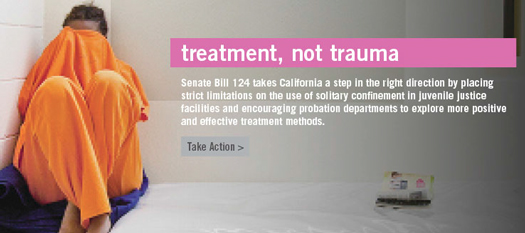By Charlene Muhammad CHARLENEM
Stop using solitary confinement to punish juveniles, say advocates

LOS ANGELES–Youth advocates are calling on the California State Assembly to adopt legislation that would ban the use of solitary confinement as punishment in juvenile facilities.
If passed, SB 124, authored by Senator Mark Leno, would not completely eradicate isolation, according to Attorney Angela Chung, a policy associate with the Children’s Defense Fund-Calif. in Los Angeles.
“It’s saying you can separate a young person if they’re an imminent threat to themselves or others … but you have to have a mental health professional talking to them,” she said.
“You can’t get rid of programming and education, and you shouldn’t use it for suicide reasons. You should be using mental health approaches to a young person dealing with suicide, not solitary confinement,” Atty. Chung told The Final Call.
SB 124 is also backed by youth advocates including the Oakland-based Ella Baker Center for Human Rights, the Los Angeles-based Youth Justice Coalition, and the California Public Defender’s Association. Solitary confinement of youth amounts to torture and should apply to those who pose a serious and imminent threat to themselves or others, instead of serving as general punishment, they say. Advocates also want isolation be limited to four hours.
SB 124 is currently in the Assembly Appropriations Committee and will soon be heard on the Assembly Floor.
Many countries have already ended the use of solitary confinement for adults and youth, and the United Nations has declared it torture, especially as it pertains to youth, Atty. Chung said.
Some facilities across the country are removing the use of solitary confinement for young people either through legislation, lawsuits or epiphanies–realizing that it is torture, ineffective and fails to rehabilitate, she added.
Alaska, Connecticut, Maine, Massachusetts, Missouri, New York, Oklahoma, Oregon, Pennsylvania and Washington, D.C. as some places that have stopped isolating youth as punishment, she said.
“By far what we’re seeing is more litigation and maybe some people really taking the right steps who are in charge of these facilities to remove it. And we know that a lot of young people in the juvenile justice system–75 to 93 percent of them–have experienced at least one traumatic event in their life and that’s how they come into the juvenile justice system,” she said.
Atty. Chung cited a recent lawsuit filed against New York City at Riker’s Island for the tragic suicide of Kalief Browder.
In early June 6, young Browder hung himself after spending three years in prison–two of those years in solitary confinement–without a trial. He was arrested for stealing a backpack and charged with second-degree robbery, but maintained his innocence. He was 16 years old when arrested. All charges were dropped, and he was ultimately released in June 2013. He killed himself after being released and complaining about beatings from guards and other inmates. He was 22 years old.
In August, his family announced plans to file a $20 million wrongful death lawsuit.
On December 17, 2014, New York Mayor Bill de Blasio announced he was ending punitive segregation for 16-17-year-old inmates on Rikers Island.
“We’re using the new Transitional Repair Unit, which gives support and therapy to adolescents instead of relying on punitive segregation, which took us backwards. And adolescents now have a chance to move to second-chance housing if they’re well behaved. This is a situation that rewards good behavior, and aids in the rehabilitation process. These are examples of the reforms that we promised that are now becoming reality,” said Mayor de Blasio.
Marsha Levick, deputy director and chief counsel for the Juvenile Law Center, a non-profit organization that advocates for the rights of children in Pennsylvania, believes there is a growing recognition that solitary confinement is a particularly harmful, damaging and traumatic for juveniles.
“The California legislation aims to drastically limit its use, in line with recent national standards adopted by the Juvenile Detention Alternatives Initiative which see solitary as a limited response to imminent risk of harm–either to the juvenile himself or to others in the facility,” Attorney Levick told The Final Call.
Once a young person has “cooled down,” the juvenile should be quickly returned to general population, she argued. If the risk of self harm or danger to others persists, other more appropriate interventions, such as mental health service providers, should be pursued, she added.
Verbal de-escalation, mental health intervention, restorative justice, positive youth development and separation with cool down, instead of isolation with no programming and education, are needed, advocates said. Facilities should focus on building healthy relationships and education rather than coercive and correctional traditional practices like boot camps, they added.
“There’s this misperception that the only way to create safety in a facility is through this practice, but that’s not true,” Ms. Chung said.












